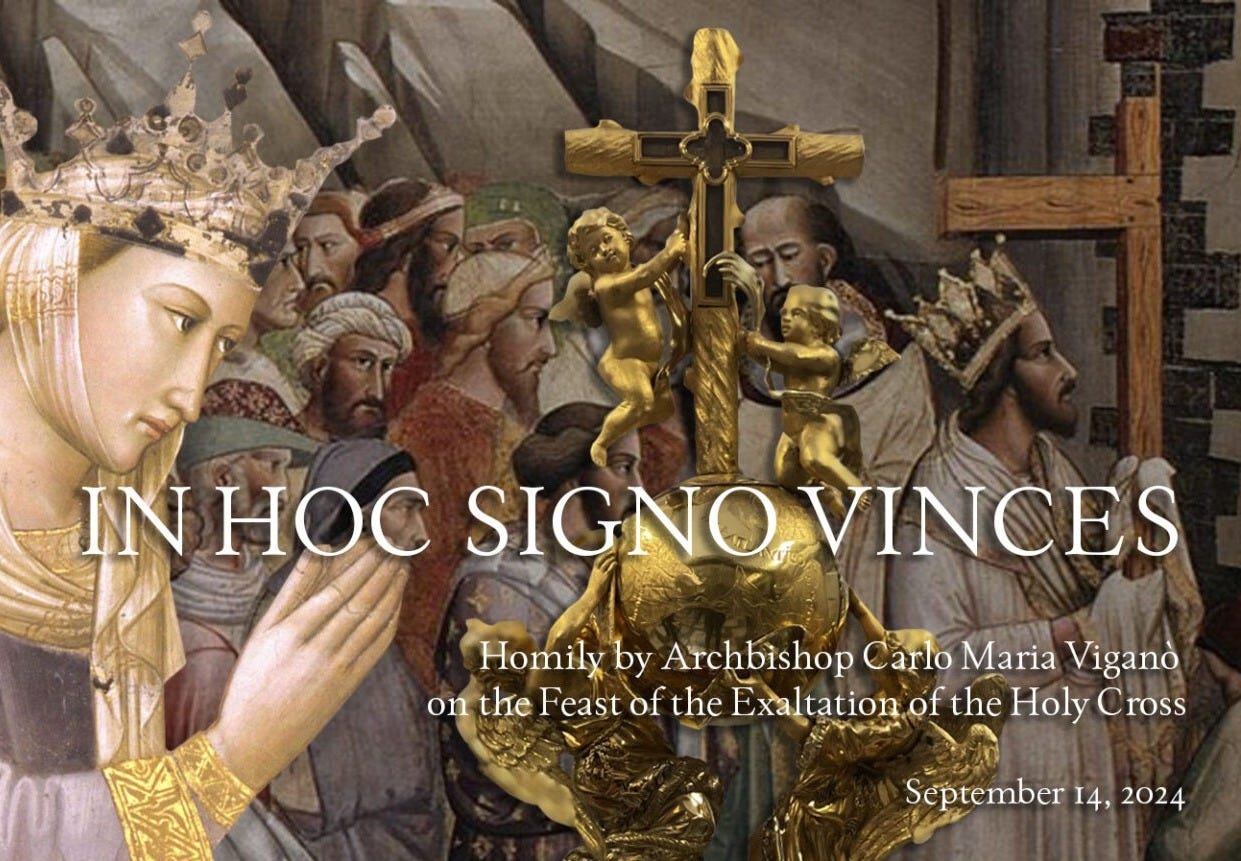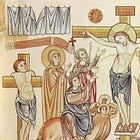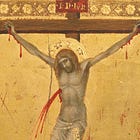+Viganò: 'In this sign, conquer' (Exaltation of the Holy Cross)
Return to the cross today: Archbishop Viganò explains the Holy Cross’s history and significance, tracing its roots from Adam and the Temple to Constantine’s Basilica, and its impact on Christian life.

Editors’ Notes
In his sermon for the Feast of the Exaltation of the Holy Cross, Archbishop Viganò discusses…
The historical account of the finding and exaltation of the Holy Cross, and what it means for our spiritual lives
The rejection for the Cross by the Conciliar-Synodal Church
Francis’ blasphemous claim that “all religions are a path to God”
The duty of all Catholics to return to the Cross today.
Archbishop Viganò mentions specifically that our own return to our own cross necessarily involves self-denial. This brings us to a pressing point for the days immediately following the Exaltation of the Holy Cross:
The Autumn/September Ember Days
When the Exaltation of the Holy Cross comes around, it’s time to start thinking about the Ember Days again.
That’s because the Autumn/September days traditionally fall on the Wednesday, Friday and Saturday following the Exaltation of the Holy Cross.1 The dates of the four sets of Ember dates are summarised in two quaint folklore rhymes:
Lenty, Penty, Crucy, Lucie.
Or more dramatically:
Fasting days and Emberings be
Lent, Whitsun, Holyrood and Lucie.
“Crucy” and “Holyrood” refer to the Exaltation of the Holy Cross. The falling of the Ember Days in the period following Holyrood provides us with a concrete link between Christ’s cross and ours, and a concrete opportunity to unite ourselves to him through penance and fasting.
This year, Ember Saturday is supplanted by the feast of St Matthew the Apostle. Nonetheless, given the recent events of Francis’ outrageously blasphemous statement – that “all religions are a path to God” – it would seem prudent to do as much penance and reparation as we can.
For more on the Ember Days, their history, meaning, their links with vocations and the priesthood, and why it’s vital we observe them, see below:
We have added some links to articles which we believe give some further context to the ideas mentioned by Archbishop Viganò, as well as some headings line breaks to make the text easier to read online.
In hoc signo vinces
Mgr. Carlo Maria Viganò
Homily on the Feast of
The Exaltation of the Holy Cross
14 September 2024
Tum Heraclius, abjecto amplissimo vestitu detractisque calceis ac plebejo amictu indutus, reliquum viæ facile confecit, et in eodem Calvariæ loco Crucem statuit,
unde fuerat a Persis asportata.Itaque Exaltationis sanctæ Crucis solemnitas, quæ hac die quotannis celebrabatur, illustrior haberi cœpit ob ejus rei memoriam, quod ibidem fuerit reposita ab Heraclio, ubi Salvatori primum fuerat constituta.
(Then Heraclius cast away his princely raiment and took off his shoes from his feet, and in the garb of a peasant easily finished the remainder of his journey, and set up the Cross once again in the same place of Calvary whence the Persians had carried it away.
Therefore the solemnity of the Exaltation of the Holy Cross, which is celebrated annually on this day, became thenceforth more illustrious, because it had been replaced by Heraclius in the same place where it had first been planted by the Savior.)
(Lect. VI – II Noct.)
The finding of the holy cross and the building of the basilica
In the seventh month, during the Feast of Tabernacles, Solomon performed the rites of consecration of the ancient Temple (1 Kings 8:2, 65); on September 14, 335, on the anniversary of the same, Constantine dedicated the Basilica of the Holy Sepulcher, to symbolize how the place of Burial – the Martyrium – and of the Resurrection – the Anastasis – together constituted the new Temple of Jerusalem.
The Roman Basilica of the Holy Cross was built by the Empress Saint Helena to house the relics of the Holy Wood after her return from her trip to the Holy Land in 325. It was there that the cult of the Cross of Christ spread throughout the Catholic world – as Dom Prosper Guéranger recalls – and has persisted to this day.
In 614 the Persian king Khosrow II invaded Jerusalem, destroyed the Constantinian Basilica, took possession of the True Cross and – in a gesture of impiety that aroused the indignation of the faithful – used that blessed wood to make his own throne.
In 628 the emperor Heraclius defeated and beheaded Khosrow, reconquered Jerusalem, rebuilt the Basilica of the Holy Sepulcher, and brought to Byzantium – abjecto amplissimo vestitu detractisque calceis ac plebejo amictu indutus, barefoot and dressed as a pilgrim – the precious relics of the Holy Cross.
The spread of the devotion to the holy cross
The historical events – because we are talking about documented history corroborated by highly authoritative testimonies – that led to the spread of the cult of the Cross and the feast of its Exaltation that we celebrate today, must not distract us from a spiritual and supernatural aspect that is fundamental for each of us.
The Cross on which Our Lord shed His Blood and died for our Redemption has been running through the history of humanity ever since. According to the Golden Legend of the Dominican bishop Jacopo da Varagine, St. Michael the Archangel ordered Seth (the son of Noah) to put three seeds of the tree of life in the mouth of the deceased Adam: from those seeds a tree was born that Solomon had cut for the construction of the Temple, but which he could not use, and which he then had buried at the bidding of the Queen of Sheba.
That wood was found at the time of Christ and used to make the Cross, then recovered by Saint Helena after the Jews had hidden it to remove it from the adoration of the faithful. As proof of its authenticity compared to those on which the thieves were executed, the Holy Wood resurrected a dead man simply by being touched to him.
Worldliness, incredulity and the rejection of the cross…
Our worldly mentality, infected with an incredulous rationalism that has nothing scientific about it, feels uncomfortable in the face of the narration of prodigious events that, through the millennia, unite Adam to Christ.
It is difficult and almost embarrassing to believe a story transmitted through the centuries in which it speaks of the Queen of Sheba and King Solomon, of the humble faith of Emperor Constantine and his mother Helena. And it is always the secularized mentality that makes us feel the Cross as an unbearable yoke, as a sign incomprehensible to the world, in which the Blood of the Savior impregnates the fibers of the wood, keeping the most holy Body of the incarnate God nailed and torn apart by the Passion.
Instead of the horrible torments of the Cross, the Conciliar Church prefers the tranquilizing image of a Christ who is risen and removed from the sorrows of the Passion.
The world rejects the Cross because it does not recognize its sinfulness and therefore does not accept Our Lord’s redeeming Passion. Si filius Dei es, descende de cruce (Mt 27:40): it is the temptation of those who do not understand that there is no victory without combat, nor the triumph of the Resurrection without the sufferings of the Cross.
… presumes to render the Church obsolete
The secularized spirit, which has penetrated the Church with the complicity of a Hierarchy without Faith and without Charity, has imposed this horizontal vision which nullifies the Redemption of Christ, His Incarnation, and His Passion.
If “all religions are a path to God,” as Bergoglio blasphemously stated a few days ago in Singapore, no Savior is needed; nor is there any need for a Church that is an instrument of salvation in the world; nor is there any need for a Pope, who is a bond of unity in the Faith within the Church.
Yet this “pope,” for whom anyone can be saved without the Revelation of Christ, claims to be recognized and obeyed by Catholics as the head of that Church which he blasphemously considers useless; and in the name of a usurped power he even dares to excommunicate those who denounce his apostasy.
Kneeling before the cross of Chrst
Three times each year, we kneel before the Cross in adoration: on Good Friday, on the day of its Invention or Finding [May 7], and finally today, on the feast of its Exaltation.
We do it duplici genu, with both knees, as before the most august Sacrament: an external gesture of adoration invites us to contemplate those two bare pieces of wood, which have crossed history and which still represent the discrimen (the watershed) of human events, until the end of time, when it will be the Cross that will shine in the sky, as anticipated by Saint John in the Apocalypse (1:7).
Before the Cross we kneel, stripping ourselves of ourselves, as Christ himself was exposed to humiliation and opprobrium like a criminal deserving of death. And before the Cross all creatures must kneel, cœlestium, terrestrium et infernorum (Phil 2:10), so that the fruit of death gathered by our First Parents in disobedience to God’s command may become the fruit of eternal life in the Sacrifice of the new Adam; a fruit that has ripened down the centuries through preparation in the Old Law, until fulfilment in the new and eternal Covenant; a fruit sprinkled with the Blood of the Immaculate Lamb, who spares us and saves us at the passage of the exterminating angel (Ex 12:13).
That Tree of Life that was the cause of our death in Eden is reborn on Golgotha as an instrument of torture and death, to give us true Life, the life of Grace, of friendship with God, with the Most Holy Trinity, life restored in Christ, true God and true Man.
Call to return to the cross, spes unica
Let us therefore return to the Cross, dear brothers, because it is truly spes unica, as we sing in the ancient hymn Vexilla Regis.
It is the only hope because in the Cross we understand the necessity of the Passion, in the plans of a God who becomes incarnate to redeem the servant, felix culpa. It is the only hope because the joys, riches, well-being, success, money, and pleasures of this world are all fallacious and deceptive. With them Satan keeps us attached to creatures, to prevent us from raising our spirit to the Creator; he binds us to fiction, so that we do not grasp reality; he deceives us with ephemeral things, while the Lord grants us the Grace to enter into eternity.
Only in this way can we understand why some saints – like Saint Francis, a model of poverty and renunciation of the world – were privileged by Christ precisely in bearing the Stigmata of the Passion. Each of us must have those Holy Wounds mystically imprinted on our souls, in the self-denial that costs us so much but which alone makes us truly similar to Our Lord.
Self-denial, the embrace of our cross
Si quis vult venire post me, abneget semetipsum, et tollat crucem suam quotidie et sequatur me (Lk 9:23). Self-denial consists in embracing our cross, and in carrying it daily, every day, following Christ to Calvary. And it is our cross, that is, the one that Providence has destined for us – whether small or large – and not the one that we want to choose for ourselves, believing ourselves capable of carrying it with our own strength.
We have our own cross and also our own supernatural graces that allow us not to be crushed by it. This is the test, the certamen to be faced, if we are to attain the eternal reward and be admitted into the presence of God. Let us accept it as Heraclius, detractis calceis ac plebejo amictu indutus, so that by stripping ourselves of the garments of this world – which we are ineluctably destined to abandon – we can with Saint Paul be clothed in Christ with the new man, in justitia et sanctitate veritatis (Eph 4:24).
And so may it be.
+ Carlo Maria Viganò, Archbishop
September 14, 2024
In Exsaltatione Sanctæ Crucis D.N.J.C.
Further Reading:
HELP KEEP THE WM REVIEW ONLINE!
As we expand The WM Review we would like to keep providing free articles for everyone. If you have benefitted from our content please do consider supporting us financially.
A subscription from you helps ensure that we can keep writing and sharing free material for all.
Plus, you will get access to our exclusive members-only material!
Thank you!
There is some additional confusion now, following a reform of the calendar by John XXIII, on how the date of the September days should be calculated. Sometimes, John XXIII’s changes place the Autumn Ember Days a week after they would have been previously.
However, even the modern Vatican, when instituting the calendar for the Anglican Ordinariates, reverted to the old method of calculating the date of the Autumn Ember Days.







